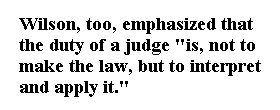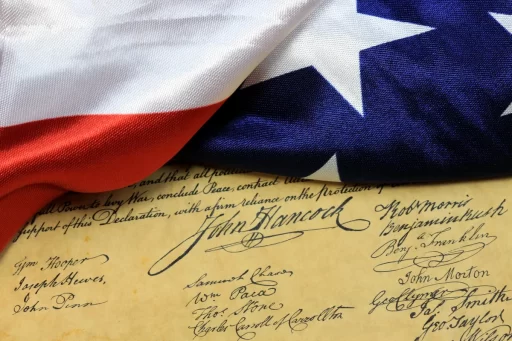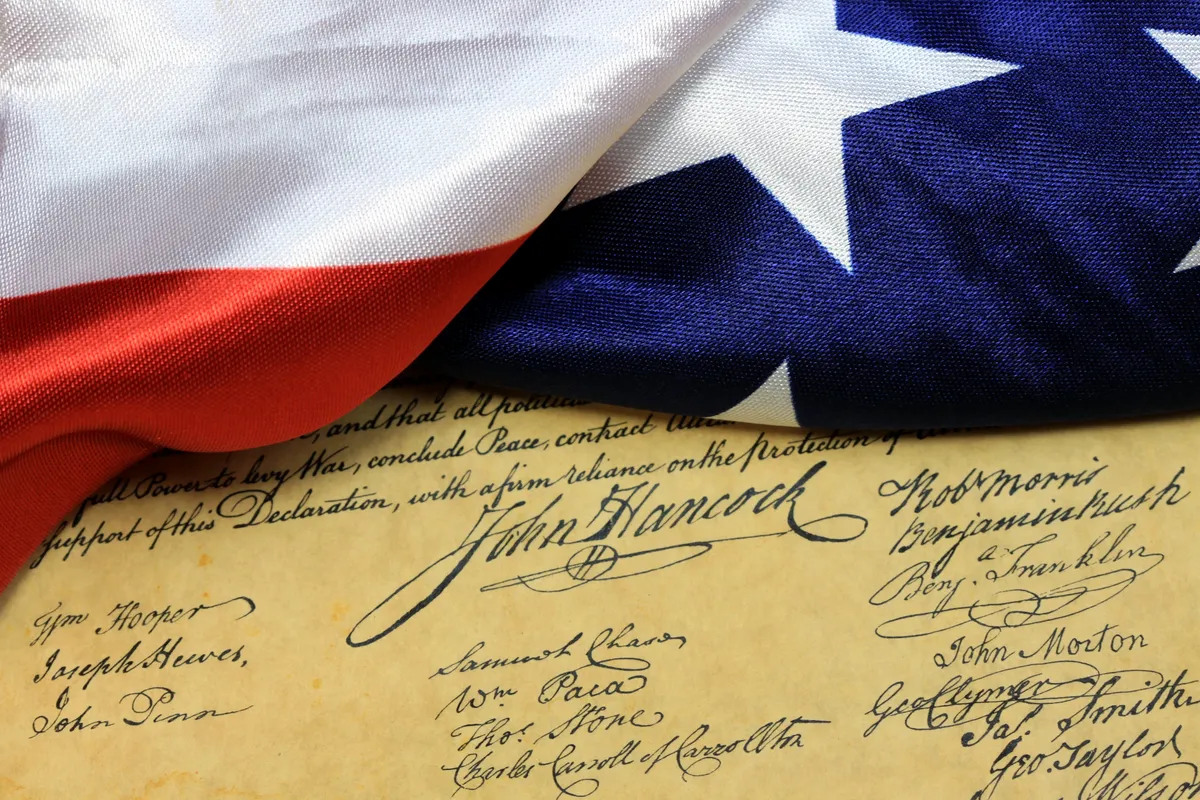The American founding fathers were heavily influenced by the model of common law set forth by William Blackstone in the 1700s. James Wilson was among those who embraced the common law model in constructing early American founding documents and in enumerating the powers of government. A member of the Second Continental Congress, signer of the Constitution, and one of the first five U.S. Supreme Court Justices, Wilson looked to common law principles to form his decisions in Congress and the Court. [1]
Born in Scotland and educated at the University of St. Andrews, Wilson emigrated to the American colonies in 1765 in search of new opportunities, fame and fortune. Within a few years of opening his private law practice in Reading, Pennsylvania, his practice stretched over seven counties in the colony. His reputation as a good common law lawyer thus led him to service as a delegate to the First Continental Congress, and later, the Constitutional Convention.
In the Constitutional Convention, Wilson was a strong advocate of popular sovereignty and a strong national government. Such a stance is evidence of his belief in the principle of self-government: “The Articles of Confederation did not provide a national government strong enough to govern effectively. Yet they were hesitant to create a governmental monstrosity that might wipe out self-government at the state and local levels. The new Constitution of 1787 resolved these concerns. The safeguard for local self-government was the federal system.” [2]
Of the Constitution Wilson says, “When I reflect how widely men differ in their opinions, and that every man (and observation applies likewise to every state) has an equal pretension to assert his own, I am satisfied that anything nearer to perfection could not have been accomplished.” [3]
Blackstone’s Common Law Theory
William Blackstone, an 18th century British jurist and contemporary of James Wilson’s, set forth a common law model with two main categories–the law of nature and the law of revelation. In his Commentaries on the Laws of England, Blackstone explains that the law of nature establishes a rule of moral conduct based on God’s law, which recognizes man as created in the image of God. This rule of moral conduct imposes a rule of action upon man that includes duties to God, self, and neighbor. “And it is that rule of action, which is prescribed by some superior, and which the inferior is bound to obey.” [4]
Blackstone defines the law of nature as “the eternal, immutable laws of good and evil, to which the Creator himself in all his dispensations conforms; and which he has enabled human reason to discover, so far as they are necessary for the conduct of human actions.” [5] The law of nature, therefore, sets up an objective standard of morality and right and wrong actions as dictated by God. This standard is based on the understanding that man is created in the image of God, and that he (man) has God-given intuitive knowledge by which he knows the objective standard, and is thus responsible for adhering to it.
Understanding the principle of the law of nature leads to the logical conclusion that man has no subjective right to do something that has been established as objectively wrong. Any act that violates the image of God in oneself or in other men is considered malum in se, or bad in and of itself. An action that is malum in se, therefore, violates not only one’s duty to God (to live life for His glory), but also violates duty to self in that it could potentially compromise one’s health and well-being. Therefore, the law of nature is the first standard by which an individual’s actions should be gauged.
A second standard by which an individual’s actions should be gauged is the standard of malum prohibitum, or bad because prohibited. This standard is established based on certain revealed laws seen in the law of nature and nature’s God. Government has the authority to pass laws that set forth a rule of civil conduct only, and such laws must be in accordance with the law of nature. Such laws would make certain actions malum prohibitum. Blackstone states, “For the end and intent of [municipal] laws being only to regulate the behavior of mankind, as they are members of society . . . they have consequently no business or concern with any but social or relative duties.” [6]
Blackstone saw that the role of government is not to enumerate rights, but to protect those rights already imparted to every individual by God. His common law model establishes that the duty of government is to command what is right and prohibit what is wrong. He states, “The principal aim of society is to protect individuals in the enjoyment of those absolute rights which were vested in them by the immutable laws of nature.” [7] The early American founders, including James Wilson, thus constructed a framing document that reinforced the truth of certain unalienable rights while defining and limiting the powers of government.
Common Law and the Founders
In the Declaration of Independence, the founding fathers refer to “certain unalienable rights . . . among these are life, liberty, and the pursuit of happiness.” [8] This statement is not an endowing of rights by the government, but merely an enumeration of God-given rights. Blackstone asserted that man has a duty to “pursue his own true and substantial happiness.” [9] Man’s pursuit of happiness, as understood by both Blackstone and the founders, is dependent upon his adherence to the laws of eternal justice and God’s moral law. It is impossible for man to be happy without keeping these laws. “[The Creator] has so intimately connected, so inseparably woven, the laws of eternal justice with the happiness of each individual, that the latter cannot be attained but by observing the former; and if the former be punctually obeyed, it can not but induce the latter.” [10]
In addition, Wilson believed, concurring with Blackstone, that government is duty-bound to regulate actions which are inconsistent with the law of nature. For example, the Judiciary Act of 1789 gave federal circuit courts jurisdiction “over offenses cognizable under the authority of the U.S.” [11] But neither “crime” nor “authority” were defined for purposes of that act. Wilson, then Supreme Court Justice, took the view that the federal common law incorporates the law of nations because both are a part of natural law. That is, Wilson saw all laws made by man as falling under the scope of the law of nature and nature’s God, and therefore necessarily consistent with that supreme law.
In establishing the role and scope of government, the early American founders were influenced by Blackstone’s definition of law in his Commentaries on the Laws of England: “A rule of civil conduct prescribed by the Supreme power in a state, commanding what is right, and prohibiting what is wrong.” [12] Wilson clearly understood that “it is the nature of man to pursue his own interest, in preference to the public good.” [13] He thus knew that a governmental system was necessary that encouraged the proper self-government of the people while effectively restraining the inherent vices of human nature. Wilson was confident that such had been achieved through the architecture of the Constitution of the United States, saying, “I am bold to assert, that it is the best form of government which has been offered to the world.” [14]
Wilson on the Judiciary
Under Chief Justice John Jay, and appointed by George Washington, Wilson was one of the first five Justices on the U.S. Supreme Court. As mentioned, Wilson accepted Blackstone’s common law model that set forth legal and behavioral standards based on the law of nature and nature’s God. With a full understanding of Blackstone’s view of the role of judges and the courts, we can see that Wilson rejected judicial activism as readily as did Blackstone.
Blackstone differentiates the role of the legislator versus the role of judges and the courts in Section III of Commentaries on the Laws of England: “How are these customs and maxims [i.e. laws] to be known, and by whom is their validity determined? The answer is, by the judges in the several courts of justice. They are the depositories of the laws; the living oracles, who must decide in all cases of doubt, and who are bound by an oath to decide according to the law of the land . . . not delegated to pronounce a new law, but to maintain and expound the old one. . . . And indeed, these judicial decisions are the principal and most authoritative evidence that can be given of the existence of such a custom as shall form a part of the common law [emphasis added].” [15] In his 1791 lectures, Wilson, too, emphasized that the duty of a judge “is, not to make the law, but to interpret and apply it.” [16]
James Wilson would vehemently reject the judicial activism prevalent in America’s federal courts.  Contemporary secular natural law jurisprudence removes the objective standard of the law of nature and establishes moral relativism. This false ‘standard’ sets the stage for the judicial activism that the Framers cast off as being deleterious to the security of individual inalienable rights. On the heels of the Constitutional Convention, Wilson stated, “The first and governing maxim in the interpretation of a statute is, to discover the meaning of those who made it.” [17]
Contemporary secular natural law jurisprudence removes the objective standard of the law of nature and establishes moral relativism. This false ‘standard’ sets the stage for the judicial activism that the Framers cast off as being deleterious to the security of individual inalienable rights. On the heels of the Constitutional Convention, Wilson stated, “The first and governing maxim in the interpretation of a statute is, to discover the meaning of those who made it.” [17]
Wilson on Slavery
Wilson’s antislavery sentiments were based on the common law principle of equality. Blackstone’s common law view of equality is composed of two parts: 1) equality is prescribed by the law of nature, and 2) in civil terms, there are no special privileges afforded to anyone. Any privilege or benefit that an individual receives should be as a result of a right that was given up, otherwise, the principle of equality is violated. The converse is also true, that if any privilege or benefit due an individual by virtue of the inalienable rights of mankind is withheld, the principle of equality is also violated.
Wilson concurred with Blackstone’s assertion of the principle of equality as protected in the common law. He specifically applied this principle to the issue of slavery, a practice he strongly opposed. Wilson states, “Slavery, or an absolute and unlimited power in the master over life and fortune of the slave, is unauthorized by the common law . . . The reasons which we sometimes see assigned for the origin and the continuance of slavery appear, when examined to the bottom, to be built upon a false foundation. In the enjoyment of their persons and their property, the common law protects all.” [18]
Conclusion
James Wilson was heavily influenced by the model of common law set forth by William Blackstone in the 1700s, as were many of the founding fathers. By embracing the common law model in constructing early American founding documents, Wilson and the Framers attempted to ensure a governmental system that would truly be by the people, and for the people.
Current judicial activism and an overly extended federal government fly in the face of the structure established by the founding fathers. Wilson predicted this opposition shortly after the Constitutional Convention, saying, “It is the interest of a very numerous, powerful, and respectable body to counteract and destroy the excellent work produced by the late Convention.” [19] A return to the common law model of Blackstone, a model that recognizes the inalienable rights inherent in the law of nature and nature’s God, a model that was fully embraced by Wilson and the founders, is a necessary and urgent step on the road to restoring the greatness of America’s federal repubic.
- 1 “James Wilson,” Northwestern University: U.S. Supreme Court Database [on-line database]; available from http://www.nwu.edu; Internet; accessed 24 November 1997.
- 2 K. Alan Snyder, If the Foundations Are Destroyed: Biblical Principles and Civil Government (Marion, Ind.: Principle Press, 1994), 55.
- 3 James Wilson, “State House Yard Speech on the Constitution,” 6 October 1787; as quoted in Richard W. Leopold, Arthur S. Link and Stanley Coben, Eds., Problems in American History (New York: Prentice-Hall, 1952), 148.
- 4 William Blackstone, Commentaries on the Laws of England (1765); as quoted in Gary Amos, Biblical Principles of Law and the Common Law (Virginia Beach: Regent University, 1996), 24.
- 5 Ibid, 25.
- 6 Ibid, 31.
- 7 Ibid.
- 8 Declaration of Independence, adopted 4 July 1776.
- 9 Gary Amos, The Common Law, 25.
- 10 Ibid.
- 11 Mr. Orth, Legal History Outline 1995 [on-line]; available from http://www.geocities.com/Athens/4064; Internet; accessed 14 November 1997.
- 12 Gary Amos, The Common Law, 25.
- 13 Leopold, Link and Coben, Eds., Problems in American History, 149.
- 14 Ibid.
- 15 Gary Amos, The Common Law, 29.
- 16 James Wilson, 1791 Lectures; as quoted in Robert Green McCloskey, Ed., The Works of James Wilson (Cambridge: Harvard University Press, 1967), 502.
- 17 James Wilson, Of the Study of Law in the United States; as quoted in Robert Green McCloskey, Ed., The Works of James Wilson (Cambridge: Harvard University Press, 1967), 75.
- 18 McCloskey, The Works of James Wilson, 605.
- 19 Leopold, Link and Coben, Eds., Problems in American History, 149.





